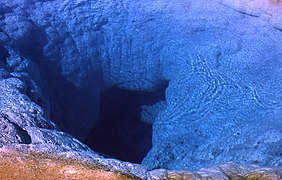
Yellowstone National Park is an American national park located in the western United States, largely in the northwest corner of Wyoming and extending into Montana and Idaho. It was established by the U.S. Congress and signed into law by President Ulysses S. Grant on March 1, 1872. Yellowstone was the first national park in the U.S. and is also widely held to be the first national park in the world. The park is known for its wildlife and its many geothermal features, especially Old Faithful geyser, one of its most popular. While it represents many types of biomes, the subalpine forest is the most abundant. It is part of the South Central Rockies forests ecoregion.

The geothermal areas of Yellowstone include several geyser basins in Yellowstone National Park as well as other geothermal features such as hot springs, mud pots, and fumaroles. The number of thermal features in Yellowstone is estimated at 10,000. A study that was completed in 2011 found that a total of 1,283 geysers have erupted in Yellowstone, 465 of which are active during an average year. These are distributed among nine geyser basins, with a few geysers found in smaller thermal areas throughout the Park. The number of geysers in each geyser basin are as follows: Upper Geyser Basin (410), Midway Geyser Basin (59), Lower Geyser Basin (283), Norris Geyser Basin (193), West Thumb Geyser Basin (84), Gibbon Geyser Basin (24), Lone Star Geyser Basin (21), Shoshone Geyser Basin (107), Heart Lake Geyser Basin (69), other areas (33). Although famous large geysers like Old Faithful are part of the total, most of Yellowstone's geysers are small, erupting to only a foot or two. The hydrothermal system that supplies the geysers with hot water sits within an ancient active caldera. Many of the thermal features in Yellowstone build up sinter, geyserite, or travertine deposits around and within them.

The Fountain Paint Pot is a mud pot located in Lower Geyser Basin in Yellowstone National Park.
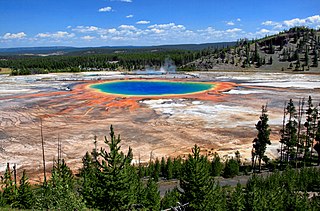
The Grand Prismatic Spring in Yellowstone National Park is the largest hot spring in the United States, and the third largest in the world, after Frying Pan Lake in New Zealand and Boiling Lake in Dominica. It is located in the Midway Geyser Basin.

Brilliant Pool is a hot spring in the Upper Geyser Basin of Yellowstone National Park in the United States.

Emerald Spring is a hot spring located in Norris Geyser Basin of Yellowstone National Park.

Fishing Cone, also known as Fishing Pot Hot Springs is a geyser in the West Thumb Geyser Basin of Yellowstone National Park in the United States.
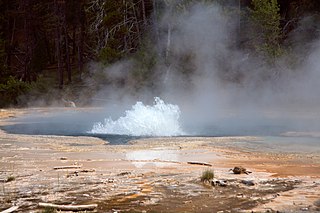
Solitary Geyser is a fountain-type geyser in Yellowstone National Park, located above the Upper Geyser Basin. Eruptions last about a minute and are four to eight minutes apart; most eruptions are less than six feet in height. It is very distinctive with clear blue water underneath and a base that is tinted orange. Solitary Geyser is accessible via the Observation Point loop trail behind Old Faithful.

Beauty Pool is a hot spring in the Upper Geyser Basin of Yellowstone National Park in the United States.
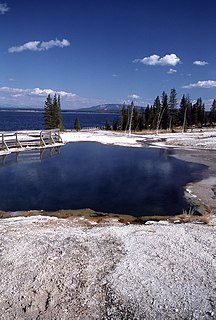
Black Pool is a hot spring in the West Thumb Geyser Basin of Yellowstone National Park in the United States.

Economic Geyser is a geyser in the Upper Geyser Basin of Yellowstone National Park in the United States.
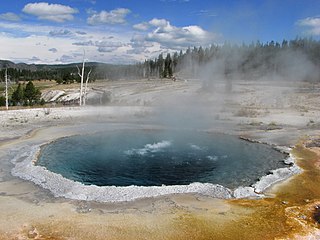
Crested Pool is a hot spring in the Upper Geyser Basin in Yellowstone National Park. The spring is 42 feet deep. It is named for the "crest" which surrounds the pool. Although it is considered a spring, Crested Pool sometimes erupts like a geyser.
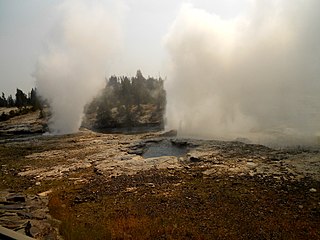
Fan and Mortar Geysers are two geysers in the Upper Geyser Basin in Yellowstone National Park. For the past several decades, they have erupted in concert with one another and are generally talked about together. The records detailing these geysers' known eruptive history shows that they have been infrequent and irregular performers.

The following articles relate to the history, geography, geology, flora, fauna, structures and recreation in Yellowstone National Park.

Doublet Pool is a hot spring in the Upper Geyser Basin of Yellowstone National Park, Wyoming.

White Dome Geyser is a geyser located in the Lower Geyser Basin in Yellowstone National Park in the United States.

Opal Pool is a hot spring in the Midway Geyser Basin of Yellowstone National Park, Wyoming. Opal Pool usually has a temperature of approximately 132 °F (56 °C). Though usually active as a hot spring, Opal Pool is considered a fountain-type geyser.
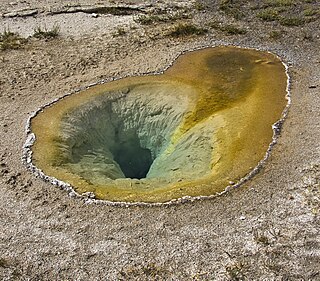
Belgian Pool is a hot spring in the Upper Geyser Basin of Yellowstone National Park, Wyoming. Originally named Oyster Spring, it was renamed after a visitor from Belgium fell into it in 1929 with fatal results. The spring is less hot than other features in the area, at about 180 °F (82 °C), but still sufficiently hot for severe thermal burns. References to a "Belgian Geyser" in the 1930s may refer to this feature.

Ear Spring is a hot spring in the Upper Geyser Basin of Yellowstone National Park in the United States. Located close to Old Faithful, on rare occasions Ear Spring will erupt as a geyser, and can shoot rocks and debris as well as water more than 25 feet (7.6 m) for a few minutes. On September 15, 2018, Ear Spring was seen on the National Park Service webcam at Old Faithful erupting for a minute and reached heights of 20 to 30 ft. This was the largest eruption the pool may have had since 1957. The eruption tossed small rocks out and the heated water killed the surrounding bacterial mats that normally thrive in less heated conditions. Likely related to the eruption of Ear Spring, a new thermal feature opened up under the pedestrian boardwalk near Pump Geyser which resulted in the National Park Service temporarily closing off the boardwalk. This new thermal feature was spouting water the night of September 18-19, 2018. Additionally, Doublet Pool and North Goggles Geyser have both been more active in the period immediately after the rare eruption of Ear Spring.

Black Sand Basin is one of a grouping of geothermal hot springs and geysers located in the Upper Geyser Basin of Yellowstone National Park, Wyoming. The spring is too hot to use as a mineral bath as its scalding 200 °F (93 °C) or hotter water has proven to be fatal. In the winter, a marked ski trail runs from the Old Faithful Visitor Center to Black Sand Basin























